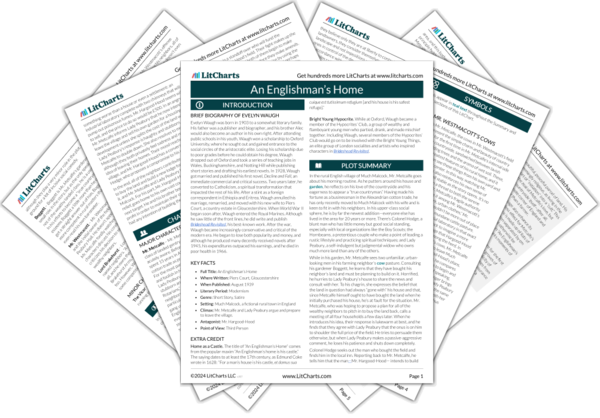The four upper-class households in Much Malcock react to the prospect of development with comically hyperbolic horror. Their initial fear about what Mr. Hargood-Hood will build on the land is soon inflated into visions of poorly built council houses (affordable, government-owned housing communities for the poor) and bungalows. Mr. Hargood-Hood, who turns out to be a country gentleman himself, preys expertly upon such fears by painting a picture of something even worse: a massive industrial laboratory pumping smog out into the bucolic landscape. The neighbors’ disgust at these nightmare scenarios is rooted in two underlying fears: first, that masses of lower-class people will move into the area in pursuit of affordable housing or jobs, and second, that the beautiful countryside they love will be “ruined” and made ugly—two fundamentally elitist concerns that prioritize relatively superficial desires over all else.
Development is presented as an extreme threat to the area’s beauty, which is itself cultivated with farms and gardens. For Mr. Metcalfe, the image of Mr. Westmacott calling his cows in his field is emblematic of this rustic charm, and in this manner, Mr. Westmacott becomes a voiceless symbol of unspoiled land. For Lady Peabury, this symbol of unspoiled land is embodied by her sprawling gardens replete with lily ponds and lead flamingoes—a planned, artificial form of natural beauty. The value that people like Mr. Metcalfe and Lady Peabury place on the landscape stems almost solely from its appearance, which they believe only they are at liberty to control. As existing landowners, they consider themselves part and parcel of the landscape and not impositions upon it. As long as they are the ones in control of the developments, then, they can make them in accordance with their own stuffy aesthetic and elitist principles rather than utility or economy. By highlighting this dynamic, Waugh pokes fun at the gentry’s hypocrisy, highlighting the fact that they funnel money into developing the land even though this is exactly what they wanted to avoid in the first place. The only difference, it seems, is that the Boy Scout lodge they build aligns with their idea of what a quaint and charming country landscape should look like. And this, in turn, reveals that their elitist values drive them to behave rather hypocritically, ultimately deciding that they can develop the land as long as doing so benefits them.
Hypocrisy and Elitism ThemeTracker

Hypocrisy and Elitism Quotes in An Englishman’s Home
For Metcalfe was but lately initiated into the cult of the countryside, and any features of it still claimed his devotion—its agricultural processes, its social structure, its vocabulary, its recreations; the aspect of it, glittering now under the cool May sunshine, fruit trees in flower, chestnut in full leaf, the ash budding; the sound and smell of it—Mr. Westmacott calling his cows at dawn, the scent of wet earth and Boggett splashing clumsily among the wall-flowers; the heart of it—or what Mr. Metcalfe took to be its heart—pulsing all round him; his own heart beating time, for was he not part of it, a true countryman, a landowner?
Lady Peabury lived at Much Malcock House, whose chimneys, soon to be hidden in the full foliage of summer, could still be seen among its budding limes on the opposite slope of the valley[…]. She was a widow and, like Mr. Metcalfe, had come to Much Malcock from abroad.
Foreign visitors impressed by the charges of London restaurants and the splendour of the more accessible ducal palaces often express wonder at the wealth of England. A half has not been told them. It is in remote hamlets like Much Malcock that the great reservoirs of national wealth seep back into the soil.
Build. It was a word so hideous that no one in Much Malcock dared use it above a whisper. “Housing scheme,” “Development,” “Clearance,” “Council Houses,” “Planning”—these obscene words had been expunged from the polite vocabulary of the district, only to be used now and then, with the license allowed to anthropologists, of the fierce tribes beyond the parish boundary. And now the horror was in their midst, the mark of Plague in the court of the Decameron.
He wants £500. It is excessive, but I am prepared to pay half of this if you will pay the other half. Should you not accede to this generous offer I shall take steps to safeguard my own interests at whatever cost to the neighbourhood…
P.S. —I mean I shall sell the Hall and develop the property as building lots.
In the doomed field Mr. Westmacott, almost for the last time, was calling his cattle; next week building was to begin and they must seek other pastures. So, in a manner of speaking, must Mr. Metcalfe.
The great shadows of the cedars lay across the lawn; they had scarcely altered during her long tenancy, but the box hedge had been of her planting; it was she who had planned the lily pond and glorified it with lead flamingoes […] the flowering shrubs were hers; she could not take them with her where she was going. Where? She was too old now to begin another garden, to make other friends. She would move, like so many of her contemporaries, from hotel to hotel […].
They drove to Mr. Hargood-Hood’s home, a double quadrangle of mellow brick that was famous far beyond the county. On the days when the gardens were open to the public, record crowds came to admire the topiary work, yews and boxes of prodigious size and fantastic shape which gave perpetual employment to three gardeners. Mr. Hargood-Hood’s ancestors had built the house and planted the gardens[...]. A sterner age demanded more strenuous efforts for their preservation.
Together the two brothers unfolded the inch ordnance map of Norfolk, spread it on the table of the Great Hall and began their preliminary, expert search for a likely, unspoilt, well-loved village.











